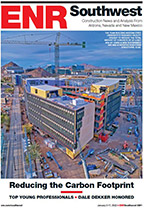Low-E windows currently account for about 70% of all glazing sales. "We helped the window companies understand how to use the coatings and the architects and engineers understand how to use the windows," says Selkowitz.
The other FLEXLAB precursor was a partial office-floor mock-up built at a cost of $1 million to test, specify and select automated shading and dimmable lighting systems for The New York Times' 52-story headquarters, completed in 2007 (ENR 3/26/07 p. 28). The Berkeley lab later did a post-occupancy study: The systems cut lighting energy use by 50% and overall energy use by 24%.
"Our mock-up project would not have been possible without Steve," says David Thurm, then a Times' senior vice president. "He was able to lead us and the manufacturers through the complexities of the data to achieve practical, cost-effective results."
Selkowitz had hoped the success of the Times project would prompt other owners to invest in daylighting systems. "By and large, that did not happen," he says.
The permanent FLEXLAB, less costly and more sustainable than a temporary, project-specific mock-up, is his response to his disappointment. For owners, FLEXLAB offers integrated building-system performance validation during design. Lessons learned from a room-sized test bed can be applied to a floor, a building or even an entire real estate portfolio for energy retrofits. "We're all about scaling to national impact," says Selkowitz.
FLEXLAB offers a way for designers to specify cutting-edge systems with confidence and take the pain out of performance guarantees. Manufacturers can use the lab to rapidly design, prototype and test new products and systems.
"The key goal of FLEXLAB and a lot of our work is to reduce the risk of innovation," says Selkowitz.
Code officials can use the facility to fine-tune codes. That is the plan of the California Energy Commission, which is responsible for the energy portion of the state's building code. "FLEXLAB has such a public-good component," says Andrew McCallister, a CEC commissioner. "In this country, we under-invest in energy research."
FLEXLAB can prove that properly designed windows do not leak energy, and it has the potential to end the code debate about reducing the window-to-wall ratio as a way to save energy, says Helen Sanders, vice president of technical business development for dynamic glass maker SAGE Electrochromics.
Using FLEXLAB, a utility could prove a specific demand-management strategy and governments can better predict the impact of energy-efficiency programs. The lab also can be used to validate or improve modeling tools, which could influence standards.












Post a comment to this article
Report Abusive Comment